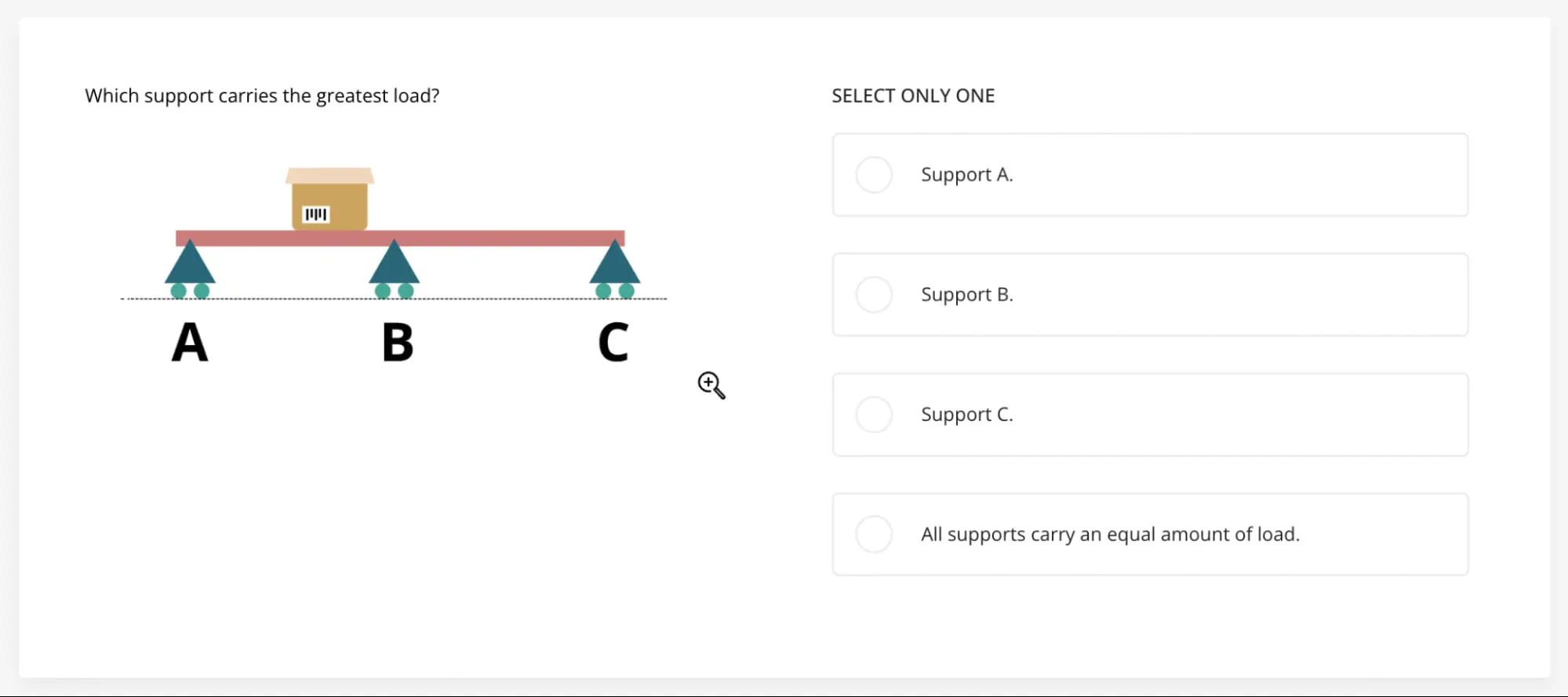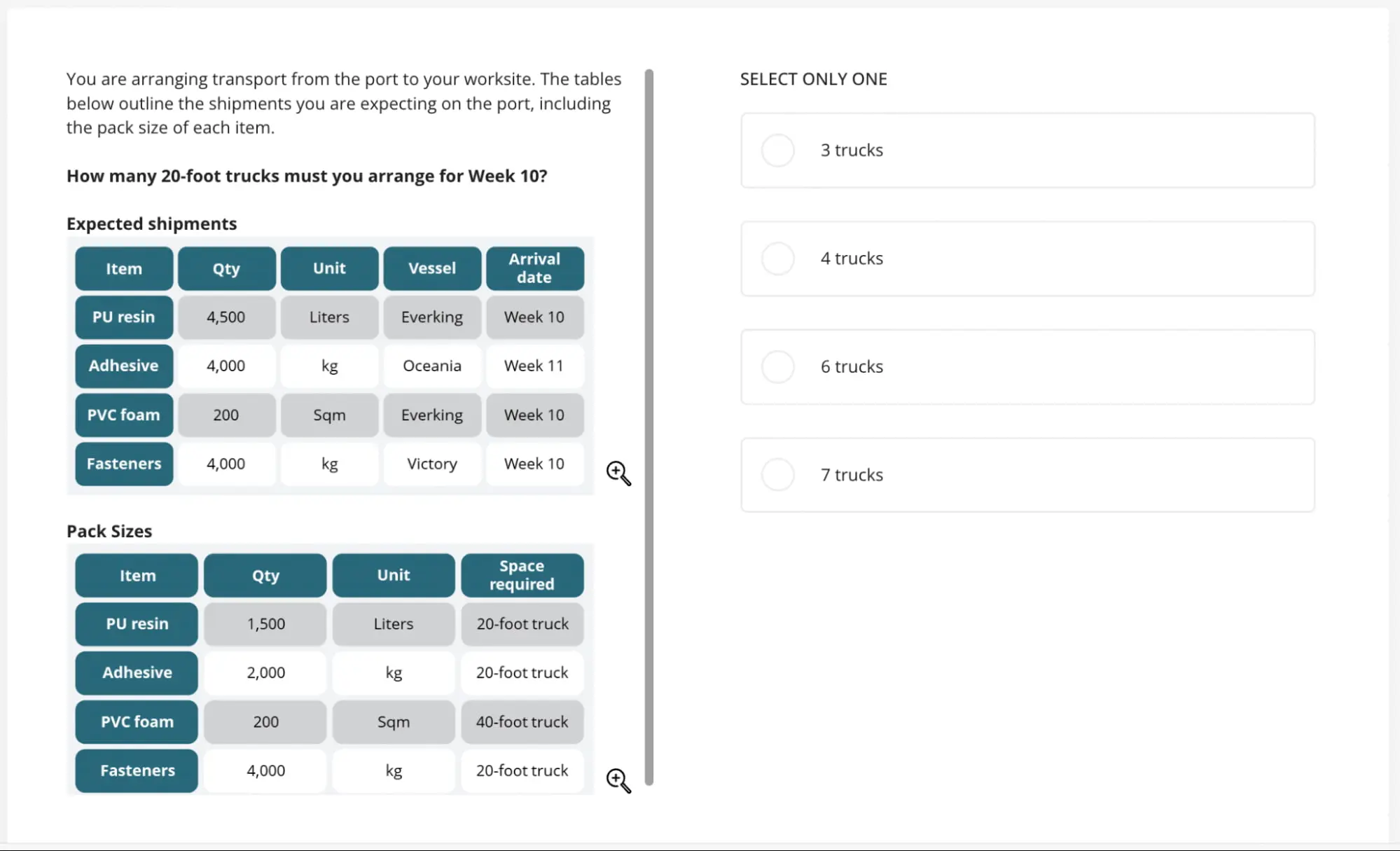Picture the following scenario.
You’ve just started a new fast-food restaurant, and orders are pouring in. But you don’t have a driver yet. Since you don’t know what skills to look for, you hire the first driver with a decent-looking resume. After a few deliveries, you start getting complaints: The food is late and arrived cold, there’s been an accident, and your vehicle now needs to be repaired.
Sounds like a nightmare, right?
Yes, but don’t worry; this article covers the top skills to look for in a driver and how talent assessments help you find the perfect candidate and avoid the above situation.
Table of contents
What is a driver?
A driver is a person who operates a car, truck, bus, or some other kind of motorized vehicle to transport passengers or goods from one location to another. The primary responsibility of a driver is to safely navigate the vehicle and abide by traffic laws or other country-specific regulations. They must also ensure passengers’ wellbeing, comfort, and safety and the secure transportation of goods.
Types of drivers
Depending on the type of work and your industry, there are several types of drivers:
Delivery drivers: Transport goods or packages to various locations
Truck drivers: Specialize in transporting large quantities of goods across distances
Bus drivers: Ensure the safe and efficient transport of passengers
Taxi drivers: Provide on-demand transportation for passengers
Personal driver/professional chauffeur services: Offers private driving services, often for high-end clients in luxury vehicles
Remember that different driver service positions may have extra requirements. For example, truck or bus drivers may require certain certifications, such as a Commercial Driver’s License (CDL).
Why hire a driver?
Demand for drivers is growing within the blue-collar job market.
Taxi drivers, for example, are one of the fastest-growing jobs, with a projected growth rate of 28% between 2021 and 2031. This growth shows an increasing need for reliable transportation and suggests that investing in a skilled driving workforce is necessary to meet growing customer demands.
Drivers serve as the front face of many companies. A delay in delivery or transport can lead to dissatisfaction, affecting the customer's perception of your company and potentially harming your business's reputation
Bottom line: You need to hire professional, qualified drivers who meet specific requirements. This is a key part of customer satisfaction and operating a successful business.
8 fundamental skills to look for in an excellent driver
To find the best drivers for your business, you need to determine their knowledge and experience using pre-employment tests.
Skills-based hiring helps you hire the right driver much more efficiently than traditional resumes. We’ve compiled two types of skills to test for: hard and soft skills.
Driver hard skills:
Mechanical reasoning
Transport coordination
Driver soft skills:
Communication
Time management
Problem-solving
Attention to detail
Understanding instructions
Customer service
Hard skills
The two primary hard skills to look for in a driver are:
1. Mechanical reasoning
Mechanical reasoning assesses candidates' grasp of basic mechanical and physical principles. These include force and movement, velocity, and the mechanics of pulleys, gears, and wheels. Such skills are paramount for drivers because they help conduct essential vehicle maintenance.
Drivers can also use mechanical reasoning skills to proactively identify potential issues, and resolve them promptly, ensuring vehicle reliability and safety.
You can assess driving candidates with a Mechanical Reasoning test:
If you’re interested in more sample questions, check out the Mechanical Reasoning test preview.
2. Transport coordination
A Transport Coordinator test evaluates essential skills in route planning, inbound and outbound transportation management, and logistics.
These competencies are crucial for drivers to anticipate potential challenges, minimize delays, and adapt to unforeseen traffic or weather conditions. Transport coordinator skills help them deliver on time, every time.
By assessing these skills through a test, you ensure your drivers can maintain efficiency and reliability in their deliveries.
Soft skills
Soft or “power” skills are as crucial as technical driving skills for ensuring a high-quality driving service. These interpersonal abilities enable drivers to understand and meet client needs and navigate difficult situations.
3. Communication
Communication skills measure a driver’s proficiency in listening attentively, understanding and interpreting verbal concepts, and applying professional etiquette.
Drivers frequently communicate with clients and logistics centers. Effective communication enables drivers to accurately report estimated times of arrival (ETAs), quickly address any arising issues, and ensure smooth operational flow.
By assessing communication skills, you can ensure your drivers are capable of providing timely updates and solving problems efficiently. This is key to maintaining the reliability and trustworthiness of your business.
You can use the Communication test to gauge this skill accurately:
4. Time management
The Time Management test is designed to identify candidates who excel in planning ahead, prioritizing tasks, and executing their duties efficiently without distractions.
Managing time is crucial for drivers tasked with delivering goods and transporting passengers punctually.
Solid time management skills ensure your drivers can navigate their schedules stress-free and can adapt to unforeseen circumstances without delay.
These skills also help drivers be punctual – crucial for passenger satisfaction and the timely delivery of goods.
5. Problem-solving
Testing for problem-solving can identify candidates who are good at the following:
Adjusting their schedules
Making informed decisions amidst unforeseen circumstances
Analyzing unexpected situations to determine the best possible outcomes
This skill set is invaluable for drivers who may encounter delays or accidents through no fault of their own.
By using the Problem Solving test, you can select drivers who are well-equipped to navigate and overcome the complexities of the road, giving you extra peace of mind by ensuring your operations remain smooth and dependable.
6. Attention to detail
Attention to detail is a skill that helps candidates match information accurately, filter relevant details, and ensure consistency in data handling.
Business.com outlines a wide range of areas where attention to detail can create an effective organization, which include timely completion of work and improved customer experience.
Drivers need this kind of precision to avoid overlooking package pickups or stops during deliveries. Strong attention to detail helps them be thorough in their work and consider all aspects of their duties before making a decision.
By administering the Attention to Detail test, you can identify drivers who exhibit a meticulous approach to their responsibilities, ensuring the reliability and thoroughness of your delivery service.
7. Understanding instructions
The ability to understand instructions is necessary for drivers responsible for transporting goods and/or passengers, ensuring they can process and comprehend directives and carry them out correctly.
Your drivers must have this skill for smooth and timely execution of their duties, from navigating routes to handling deliveries and passenger needs.
With the Understanding Instructions test, you can be confident in selecting drivers who consistently follow through on instructions, enhancing the efficiency and reliability of your service.
Hire the best drivers with TestGorilla
Are you ready to hire the best drivers with TestGorilla’s talent assessments?
8. Customer service
The Customer Service test is designed to evaluate candidates on key aspects such as understanding customer inquiries, interacting with customers using appropriate language and attitude, and avoiding creating negative impressions.
Excellent customer service skills ensure that drivers can assist customers in a personable, patient, and professional manner, adhering to your company's protocols.
Studies by McKinsey show that improving the customer experience has boosted revenue by 2% to 7% and profitability by 1% to 2%.
5 steps on how to hire a driver
Knowing you need to hire a driver who’s a perfect match for your company is one thing; knowing the steps to hiring that driver is another.
This section outlines 5 steps you and your HR department can follow to hire the right driver each time.
Step | Description |
1. Discuss your needs beforehand | Consider the specific needs of your company: Do you need a full-time or part-time driver? |
2. Write a job description | Draft a clear and concise driver job description. We provide a template you can use. |
3. Prepare the right interview questions for drivers | Ask relevant questions to get to know your candidates and assess their skills and abilities. |
4. Use skills assessments to hire the best drivers | Skills testing helps you sift through unqualified candidates by comparing the skills you need to the skills they have |
5. Know the best places to find drivers | These include LinkedIn, your website, your vehicles, staffing agencies, and referrals |
1. Discuss your needs beforehand
Your first decision is whether to hire a part-time or full-time driver. Let’s first look at the two options and then see where to find drivers.
Freelance drivers (part-time)
Part-time or freelance drivers are helpful if you have an increase in orders for a specific season (i.e., Christmas) but don’t need drivers all year round. Also, if you’ve just started your business, you might want to opt for a part-time driver to save on costs until you build up a steady stream of revenue.
You can read our step-by-step guide on how to hire part-time employees to learn more.
In-house drivers (full-time)
If you have a large business that deals specifically with the movements of goods or people, you ideally want to hire full-time, in-house drivers.
Despite having to pay benefits and time off, having well-trained and full-time drivers who know your business inside out is a better long-term investment.
In-house drivers are also more cost-effective than third-party options like Uber Eats, since these platforms can take up to 30% of the profit, according to TouchBistro.
2. Write a job description
The next step is attracting qualified candidates.
You can achieve this by drafting a clear and concise driver job description.
Make sure to add all relevant information, such as necessary skills or certifications, expected hours, and salary details.
Below we’ve included a template you can copy and paste for your job posting. Change the wording to accompany your needs. For more information, you can check out our article on how to prepare job descriptions for a skills-based hiring approach.
Job title: [X] driver
Job summary: We’re looking to hire a driver for our [company/business/family]. If you’re an outgoing person who likes driving long distances, we would like to hear from you. Please see the main responsibilities and required experience below. If the job opening sounds like the right position for you, send your resume to [contact info]
Main responsibilities:
Driving: Transportation of passengers and/or goods and products to their designated destinations. This involves driving long distances, depending on the job.
Loading and unloading: Loading and unloading goods and products to and from the vehicle and operating machinery such as forklifts.
Route planning: Proper route planning and management are required to ensure all goods/passengers are transported to their locations in time. You should consider weather conditions and traffic before making your journey and, if necessary, make route changes to avoid delays.
Vehicle maintenance: You’re responsible for doing regular vehicle inspections and ensuring everything is in working condition. If necessary, you may be required to perform basic vehicle maintenance.
Documentation: You’re required to log and document all routes and drop-offs, as well as the goods you’re transporting, and report any issues you might encounter to your superiors.
Communication: You’re required to communicate on a daily basis with clients, dispatchers, and warehouse employees. Excellent communication skills are a necessity.
Adhering to safety regulations: You must prioritize safety at all times. This includes following traffic laws, speed limits, and other regulations to ensure your safety and that of the goods/passengers you’re transporting.
Experience and qualifications:
A valid driver’s license
A commercial driver’s license (CDL) for operating trucks and buses
At least two years of driving experience
Clean driving record
Excellent communication skills
Attention to detail
Salary: $50,000
3. Prepare the right interview questions for drivers
So you’ve shortlisted your candidates. Now, you’re ready to go ahead with your interviews.
If you need more information on how to conduct interviews, you can use our step-by-step interviewing guide.
Questions you want to ask your drivers include:
Can you describe your previous driving experience? What types of vehicles have you driven?
Have you encountered any challenging situations when doing your routes? How did you handle them?
How do you handle difficult passengers or customers?
Do you have your own vehicle (if necessary)?
How do you ensure the safety and security of your vehicle and its contents?
How do you plan your routes to ensure timely deliveries? Can you describe a situation where you had to adjust your route due to unexpected circumstances?
These interview questions aim to evaluate a candidate’s driving experience, ability to communicate effectively, attention to detail, and skills in managing time.
4. Use skills assessments to hire the best drivers
While driving may sound like an easy enough job, you can’t hire just anyone to do it.
Great drivers can lower your insurance premiums and save you money. On the flip side, reckless drivers can increase your premiums and cost you. According to Forbes, drivers in the UK hit with a CD10 (driving without due care and attention) can cause policies to increase by 31.5%.
That’s why you need a pre-employment skills testing phase in your driver recruitment process to make sure you’re hiring solid drivers.
Technical skills like driving can be assessed easily with the right tests.
Let’s take a look at a case study.
How Jigsaw improved its hiring process
Jigsaw Business Solutions improved its technical skills assessment process with skills-based hiring.
Jigsaw, specializing in gift card program management, faced challenges in evaluating candidates' technical competencies confidently. They needed a reliable method to ensure accurate hiring decisions.
Choosing TestGorilla for its fast, intuitive platform, Jigsaw could assess technical skills effectively, bringing objectivity and efficiency to their recruitment. This integration gave them a streamlined hiring process.
With pre-employment skills testing, you avoid bad hires, and your driver recruitment process becomes seamless.
5. Know the best places to find drivers
There are several places where you can advertise your driver vacancy:
On your website: The best place to start advertising is on your website, especially if you’re looking for in-house drivers. Make it obvious on the home page that you’re hiring.
On your vehicles: You can also advertise your opening by placing signs on your vehicles and instructing your current drivers to hand out your contact info to interested candidates.
Through referrals: Another way to find professional drivers is by asking for referrals. Read our employee referral program guide to create your own referral hiring strategy.
Using LinkedIn: Leveraging LinkedIn’s vast network, you can easily discover great job seekers with the specific driving qualifications and experience you need.
Through staffing agencies: Finally, whether you’re looking to hire part-time or full-time drivers, you can always rely on staffing agencies to find you driving professionals. TransForce is a great example.
How much does a driver cost?
So, how much does it cost to hire a driver for your company?
Depending on the type of driver you hire, you can expect to pay the following average salaries in the US per year:
Private driver: $54,087
Truck driver: $62,494
Bus driver: $44,841
Delivery driver: $51,300
Taxi driver: $38,707
When calculating your driver’s salary, factor in the number of hours and distance, along with any perks and benefits you might add.
Hire the best driver with TestGorilla
You now know how to hire a driver.
However, you don’t have to go it alone. Finding a driver with the necessary skills and professionalism for your business is made easy with TestGorilla.
Using our pre-employment skills tests, you can find top candidates who understand instructions, communicate effectively, and manage their time.
So don’t leave your orders undelivered. Find a great driver today by signing up for your free-forever plan or requesting a free 30-minute live demo with one of our specialists.
How to hire a driver FAQs
Here’s a look at some frequently asked questions to close out this deep dive into the skills of drivers and how to test them.
What are the qualities of a good driver?
Strong driving skills
A clean driving record
Familiarity with navigation tools
Reliability
Punctuality
Excellent communication skills
Patience
Responsibility
How do I find a driver for my business?
The first step is assessing your own needs, such as figuring out if you need a part-time or full-time driver. Next, create a job description and interview questions. Use skills tests to help you assess candidates’ actual skills. Finally, know the best places to find drivers, such as LinkedIn and through staffing agencies.
Where can I find drivers?
You can find drivers by posting job openings on online job boards, industry-specific forums, and social media platforms such as LinkedIn. Experienced drivers can also be found through staffing agencies specializing in transportation services like Transforce, and social media groups dedicated to driving professionals and personal chauffeurs.
How do I hire a delivery driver?
Create a detailed job description
Mention required qualifications and responsibilities
Screen applications for experience and run background checks to ensure a clean driving record
Use pre-employment assessments to measure candidates’ skills
Conduct interviews
Focus on customer service skills and reliability
How do I recruit local truck drivers?
Advertise in local newspapers or on your trucks
Use online job boards targeted at truckers
Reach out to truck driving schools
Offer competitive wages, benefits, and flexible schedules
Truck drivers make an average of $62,494 per year (according to Talent.com), so make sure to offer competitive wages.
How do you interview a driver?
Four questions to ask a driver include:
Can you describe your previous driving experience? What types of vehicles have you driven?
Have you encountered any challenging situations when doing your routes? How did you handle them?
How do you handle difficult passengers or customers?
How do you ensure the safety and security of your vehicle and its contents?
Related posts
Hire the best candidates with TestGorilla
Create pre-employment assessments in minutes to screen candidates, save time, and hire the best talent.
Latest posts
The best advice in pre-employment testing, in your inbox.
No spam. Unsubscribe at any time.

Hire the best. No bias. No stress.
Our screening tests identify the best candidates and make your hiring decisions faster, easier, and bias-free.
Free resources
This checklist covers key features you should look for when choosing a skills testing platform
This resource will help you develop an onboarding checklist for new hires.
How to assess your candidates' attention to detail.
Learn how to get human resources certified through HRCI or SHRM.
Learn how you can improve the level of talent at your company.
Learn how CapitalT reduced hiring bias with online skills assessments.
Learn how to make the resume process more efficient and more effective.
Improve your hiring strategy with these 7 critical recruitment metrics.
Learn how Sukhi decreased time spent reviewing resumes by 83%!
Hire more efficiently with these hacks that 99% of recruiters aren't using.
Make a business case for diversity and inclusion initiatives with this data.


























